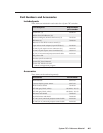
Reference Material, cont’d
System 7SC • Reference MaterialA-8
Glossary
Attenuate/attenuation — To reduce the amplitude (strength) of a signal or current.
Balanced audio — A method that uses three conductors for one audio signal. They
are plus (+), minus (-) and ground. The ground conductor is strictly for
shielding, and does not carry any signal. Balanced audio is also called
“differential audio”.
Bandwidth — A frequency range, or “band” of frequencies between the limits
defined by the “half power points”, where the signal loss is -3 dB. In audio
and video, it is this band of frequencies that can pass through a device
without significant loss or distortion. The wider the bandwidth, the better
the quality that results, such as a sharper picture or better sound. The higher
the bandwidth number the better the performance. (300 MHz is better than
250 MHz.) When a signal passes through a path with more than one device
(including cables) the limiting factor (bottleneck) in that path is the device
with the narrowest bandwidth.
Breakaway — The ability to separate audio and video signals for switching them
independently. For example: the audio and video signals from one source
may “break away” and be switched to two different destinations.
Buffer — Generally referred to as a unity gain amplifier, a buffer is used to isolate
the signal source from the load. A buffer can be used for digital or analog
signals.
IR learning — The ability of a device to receive and store infrared commands for
other devices, such as a projector. Each command is assigned to a system
operation (such as selecting an input). When an operation is executed, the
associated (learned) command is then transmitted through an IR emitter or
broadcaster to the projector, where it is executed.
IR library — Sets of downloadable infrared commands (drivers) for video
projectors available at Extron’s web site (www.extron.com).
Latching — The System 7SC room relay can operate in two modes: latching or
momentary. In the latching mode, the relay remains active (latched) until it is
manually reset (unlatched).
Level — The relative intensity (strength, voltage, volume) of an audio or video
signal. The output level can be changed by attenuation (a decrease relative to
the input signal) or gain (an increase in the signal level).
RGB delay — This is used in Triple-Action (video mute) Switching. With Triple-
Action Switching, the System 7SC switches to the new sync signal before
switching RGB (video) signals. That allows the projector to adjust to (lock
onto) the new sync timing during a brief delay before displaying the new
picture, which will appear without glitches.
3:2 pulldown — The process of matching the frame rate of film (24 frames per
second) to the frame rate of video (30 frames per second for NTSC video). In
3:2 pulldown, one frame of film is converted to three fields (1½ frames) of
video, and the next frame of film is converted to two fields (1 frame) of video.
This process is repeated (yielding 3 fields of video, 2 fields, 3 fields, 2
fields,...) until the film is fully converted to a video of approximately the
same length (duration). Most scan doublers, quadruplers, and scalers use the
premise that two fields of video equal one frame, but video created via 3:2
pulldown does not follow that pattern.


















